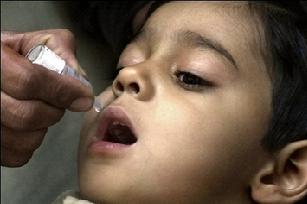
The target of getting Pakistan polio free was for 2010 but according to Dawn news report of May 15, 2008, eight cases have so far been reported in this year alone. All of these 2008 cases so far belong to Sindh province. This shows the rebirth as well as spread of the virus. It is said that peak transmission season of polio starts in June. Doctors also say that if a single case of polio is reported in any part of a country it indicates outbreak of the disease.
There is the strongest need to curtail the spread of this ghastly disease from spilling over to other provinces as well as nip it in Sindh too. So who should be blamed for this resurgence? The usual suspects ofcourse are those who manage the public health issues as well as those who administer the vaccines to children.
An excerpt from Dawn news goes like this:
The cases reported are from Nawabshah district (Jan 1), Hyderabad (Jan 25), Shikarpur (Feb 25), Karachi (April 1), Mirpurkhas (April 5), Naushahro Feroze (April 6), Jacobabad (April 9) and Dadu (April 23).
A study of the cases indicated widespread circulation of wild polio virus type-1 having its origin in Karachi which is now considered to be a reservoir serving for WPV1 circulation in the province.
The sources said that rigorous action for high-quality vaccination was needed, particularly in June before the start of the peak transmission season.
Meanwhile, Sindh Health Secretary Shafiq A. Khoso has issued notices to executive district officers, health, calling for disciplinary action against lady health workers, vaccinators and other personnel who had failed to fulfil their responsibility.
The secretary was unhappy over reports that four of the polio victims reported during the current year had not received a single routine immunisation dose, the sources said.
According to another Dawn news report of last year (April 23, 2007):
Some medical experts are of the view that the government considers such campaigns the only tool to deal with the problem and never bothers to take into account the drug used in vaccine. Sometimes the people engaged in the door-to-door campaigns may have no idea about maintaining the temperature of the vaccine, they add.
So what can we do in our own individual space to stop this menace of a diesease? One obvious thing that comes to mind is to create awareness among our circle of influence, friends and family. To educate people who may not know that a smiple vaccine of few drops may save their children from a life long disability that comes with polio.
Before ending this post, I will again give link to our co-editor Darwaish’s post on polio here, which is also a very good source of information on this disease.
Photo Credits: Ali Mohani at Flickr.com



















































Dissolving polymer microneedle patches for influenza vaccination
Physician Wilbur Chen of the Center for Vaccine Development at the University of Maryland School of Medicine in Baltimore says the new patch “might prove a powerful public health tool.” Chen points out that the patch might be especially helpful in developing countries, where electricity to keep liquid vaccines cold is in short supply, and needles and trained medical personnel are scarce. The team hasn’t conducted studies to see how long the patches can sit at room temperature, but Sullivan predicts that they would be stable on the order of months.
The latest edition of Nature Magazine is reporting possible breakthrough in fight aganist viruses.
It is just not the vaccination itself, it is the pretesting, of knowing the local conditions, training and handling, all working together to make it a success.
Yet another update on vaccination and disorders. To be clear, the debate continues. The parents are convinced it is linked and the pharma industry opposed. The courts appear to be divided.
Robert F. Kennedy, Jr. recently wrote in Huffington post and it links to a court decision: ~~the parents of yet another child with autism spectrum disorder (ASD) were awarded a lump sum of more than $810,000 (plus an estimated $30-40,000 per year for autism services and care) in compensation by the Court, which ruled that the measels-mumps-rubella (MMR) vaccine had caused acute brain damage that led to his autism spectrum disorder. ~~
The debate continues. Everyone considering vaccination for their loved one should engage fully and try to understand all aspects of the current choices. It is not a trivial matter and left to ignorance.
Health care officials should take double caution for taking decisions that will impact countless families and generations to come.
My personal anecdotal evidence convinces me that the highest rate of failed marriages have one thing in common: a child with a disability.
Vaccination is too important to be left to ignorance or chance.
Vaccines go through years of testing before and after they are approved for use. Sometimes a vaccine or a particular lot (batch) of vaccine may be withdrawn or recalled from doctor’s offices, clinics, hospitals, and other places permitted to administer vaccines.
Source: US Centers for Disease Control and Prevention
Vaccine Adverse Event Reporting System (VAERS)
Vaccines are developed in accordance with the highest standards of safety. However, as with any medical procedure, vaccination has some risks. Individuals react differently to vaccines, and there is no way to predict the reaction of a specific individual to a particular vaccine.
Approximately 30,000 VAERS reports are filed annually, with 10